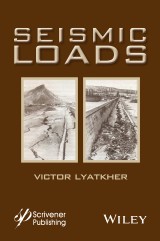Details

Seismic Loads
1. Aufl.
|
171,99 € |
|
| Verlag: | Wiley |
| Format: | EPUB |
| Veröffentl.: | 03.12.2015 |
| ISBN/EAN: | 9781118946251 |
| Sprache: | englisch |
| Anzahl Seiten: | 400 |
DRM-geschütztes eBook, Sie benötigen z.B. Adobe Digital Editions und eine Adobe ID zum Lesen.
Beschreibungen
<p>Earthquakes are a way of life on Earth, and, whether you live in an area that is often affected by earthquakes or not, every building, every road, every bridge, and, in fact, almost everything constructed by humans in which we walk, sleep, live, sit, or visit, has to be constructed to withstand an earthquake, by following local, regional, or national codes, laws, and regulations. Further to this, the science and engineering behind these constructions go further than what is mandated by government as a part of their practice. All construction, and, in general, all life on Earth, has some risk of seismic impacts.</p> <p>A comprehensive description of any seismic action may be given only on a probabilistic basis and, in general, is very bulky and quite uncertain. However, for a variety of structures or systems that meet fairly simple models of behavior during earthquakes, a general description of the seismic action is not required, for prediction of the status of such facilities or systems may be sufficient to define one or more common parameters of seismic impact. Thus, it makes sense to search for optimal parameters of influence in which optimality is understood with the greatest ease with sufficient information.</p> <p>This book contains a description of several models of seismic effects and examples of implementation of these models at specific sites. Using this information, scientists and engineers can design structures that are stronger, safer, and longer-lasting. It is a must-have for any scientist, engineer, or student working in or researching seismic loads and constructions with a view toward withstanding seismic activity.</p>
<p>Contents</p> <p>Preface vii</p> <p><b>1 Statement of the Problem 1</b></p> <p>1.1 General Scheme of Estimation of Seismic Stability 3</p> <p>1.2 Seismic Hazard 11</p> <p>1.3 Variation of Seismic Hazard 15</p> <p>1.4 Seismic Loads 20</p> <p><b>2 The Definition of Seismic Actions 29</b></p> <p>2.1 The Probability of Loads During the Earthquake of a Given Intensity 32</p> <p>2.2 Recognition of Earthquake Foci 53</p> <p>2.3 The Calculation of Seism Caused by Movement in the Earthquake Focus 61</p> <p>2.4 Physics of Focus and Control of Seismicity 82</p> <p>2.5 Seismic Forces for a Fixed Position and Energy of the Earthquake Source 99</p> <p><b>3 The Influence of Topography and Soil Conditions</b></p> <p><b>Secondary Processes 113</b></p> <p>3.1 Influence of the Canyons 113</p> <p>3.2 Dynamics of Water-Saturated Soil Equivalent Single-Phase Environment 117</p> <p>3.3 Dynamics of Water-Saturated Soil as Multiphase Medium 121</p> <p>3.4 The Real Estimates of the Property of Soils 145</p> <p>3.4.1 Mathematical Formulation of the Problem 147</p> <p>3.4.2 Examples of Calculations 152</p> <p>3.5 Landslides and Mudflows 158</p> <p>3.6 Waves on the Water 162</p> <p><b>4 Example of Determination of Seismic Loads on the Object in an Area of High Seismicity 167</b></p> <p>4.1 Assessment of Seismotectonics and Choice of Calculation of Seismicity 167</p> <p>4.2 The Parameters of Impacts 171</p> <p>4.3 Selection of Unique 179</p> <p>4.4 Numerical Models of the Focus 183</p> <p>4.5 The Influence of the Shape of the Canyon 189</p> <p><b>5 Examples of Determination of Seismic Effects on Objects in Areas of Low Seismicity 195</b></p> <p>5.1 Preliminary Analysis 195</p> <p>5.2 Assessment of Seismic Risk on Seismological Data 201</p> <p>5.3 Tectonic Structure of the Area 205</p> <p>5.4 Recognition of Seismically Active Nodes’ Morphostructure 212</p> <p>5.5 The Types of Computational Seismic Effects 225</p> <p>5.6 Analog Modeling of Seismic Effects 233</p> <p>5.7 Mathematical Modeling of Seismic Effects 237</p> <p><b>6 Stability of Structures During Earthquakes 247</b></p> <p>6.1 Stability of Concrete Dams 248</p> <p>6.2 Vibration and Strength Reserves of the High Dams 278</p> <p>6.2.1 Stability and Final Displacements of the Dam 282</p> <p>6.2.2 Stress and Strain of the Dam 287</p> <p>6.2.3 Character and Form of Dam Failure 292</p> <p>6.3 The Reliability of Groundwater Dams 296</p> <p>6.4 The Stability of Underground Structures 333</p> <p>6.5 Seismic Effects Caused by Missing Floods Through the Waterworks 340</p> <p>6.5.1 The Vibration of the Dam 345</p> <p>6.5.2 Soil Vibration Outside of the Dam 352</p> <p>6.5.3 Vibration Houses 356</p> <p>6.5.4 Results and Recomendation 360</p> <p>Conclusion 362</p> <p>References 365</p> <p>Index 375</p>
<b>Victor M. Lyatkher</b>, PhD, is a professor, engineer, and inventor.. He was educated in Moscow and Leningrad, and has developed and patented numerous processes and machines. These deal mainly with renewable energy sources such as tidal power, water turbines, and vertical axis wind turbines. He developed a new method to forecast long-term variations in the Caspian Sea level, and designed a new kind of low head turbine. Mr. Lyatkher has worked for over thirty years in the wind and hydro-power industry. He has received several prizes and awards for his accomplishments, including the Prize of the Council of Ministers of the USSR, the Award of the Indian Society of Earthquake Technology, and five medals of the All Union USSR Exhibition, gold, silver and bronze.He has published numerous books (in russian) on the subject of renewable energy, and was the original inventor of helical turbine, patented in the USSR in 1983.

















